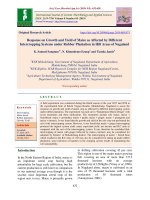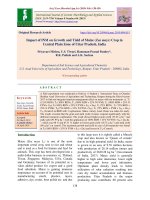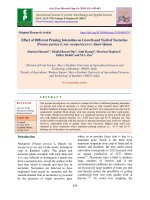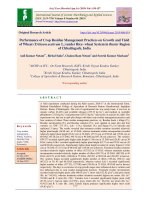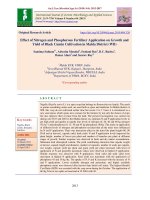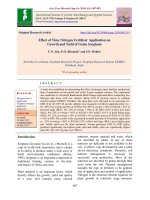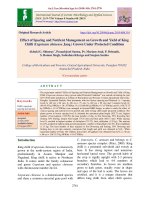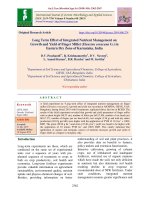Response on growth and yield of maize as affected by different intercropping systems under rubber plantation in hill areas of Nagaland
Bạn đang xem bản rút gọn của tài liệu. Xem và tải ngay bản đầy đủ của tài liệu tại đây (191.13 KB, 7 trang )
Int.J.Curr.Microbiol.App.Sci (2019) 8(5): 632-638
International Journal of Current Microbiology and Applied Sciences
ISSN: 2319-7706 Volume 8 Number 05 (2019)
Journal homepage:
Original Research Article
/>
Response on Growth and Yield of Maize as Affected by Different
Intercropping Systems under Rubber Plantation in Hill Areas of Nagaland
K. Samuel Sangtam1*, N. Khumdemo Ezung2 and Tiatula Jamir3
1
KVK Mokokchung, Government of Nagaland, Department of Agriculture,
Mokokchung-798614, Nagaland, India
2
KVK Kiphire, ICAR Research Complex for NEH Region Nagaland Centre,
Medziphema-797106, Nagaland, India
3
Agriculture Technology Management Agency, Wokha, Government of Nagaland,
Department of Agriculture, Wokha-797111, Nagaland, India
*Corresponding author
ABSTRACT
Keywords
Intercropping,
Maize based,
Rubber plantation,
Growth, Yield
Article Info
Accepted:
07 April 2019
Available Online:
10 May 2019
A field experiment was conducted during the kharif season of the year 2017 and 2018 at
the experimental farm of Krishi Vigyan Kendra, Mokokchung, Nagaland to assess the
response on growth and yield of maize crop as affected by different intercropping system
under rubber plantation. The experiment was laid out in “Randomised Block Design” with
seven treatments and three replications. The treatments include sole maize, maize +
frenchbean, maize + groundnut, maize + paddy, maize + ginger, maize + greengram and
maize + turmeric. It was found that the growth and yield of the sole crop out-performed the
rest of the intercropping system. However, it was found that maize + ginger intercropping
produced the highest system yield, maize equivalent yield, net income and B:C ratio as
compared with the rest of the intercropping system. It can, therefore be concluded that,
intercropping of maize with ginger followed by maize+ turmeric may be considered for
adoption by farmers’ of Mokokchung district. The intercropping of maize + french bean
which resulted in the B:C ratio of 1.85 may also be considered for taking up under rubber
plantation, since inclusion of legumes in the cropping system results in maintaining the
soil sustainability.
in shifting cultivation covering 42 per cent.
This region is one of the major maize growing
belt covering an area of more than 137.2
thousand hectares with an average
productivity of 1265kg/ha (Vinay et al.,1996).
In Nagaland alone, maize is cultivated in an
area of 35 thousand hectares with a total
production
of
50
thousand
tones
(Anonymous, 2001).
Introduction
In the North Eastern Region of India, maize is
an important cereal crop having high
potentiality for large scale cultivation, but the
current production is still lower in comparison
to our national average even though it is the
second- most important cereal crop of the
region next to rice. Maize is primarily grown
632
Int.J.Curr.Microbiol.App.Sci (2019) 8(5): 632-638
Intercropping is an old practice of crop
production and this system has been
developed under condition involving both risk
and constraints particularly vagaries of
weather and incidence of pests and diseases
which limit crop production. Intercropping
leads to better utilization of resources in terms
of space and time (Palaniappan, 1989).
Intercropping system is a well developed
technology
for
monoculture,
and
intercropping will no longer be just a poor
man’s practice. Thus, various evidences
suggest that intercropping can in fact; provide
a substantial yield advantage compared to
sole cropping and is recognized as a
beneficial system of crop production.
may substantially increase the yield of
cropping system. Maize along with ginger,
turmeric, rice, groundnut, green gram and
french bean could be raised as component
crops in rubber plantation.
Keeping in view the above facts, the
experiment was conducted to study the
feasibility of maize based intercropping under
rubber plantation.
Materials and Methods
A field trial was carried out during kharif
season of the year 2017 and 2018 at the
experimental farm of Krishi Vigyan Kendra,
Mokokchung, Nagaland. The experiment was
laid out in “Randomised Block Design” with
seven treatments and three replications. The
treatments consisted of various intercrop with
maize as the base crop. The intercrop
consisted of French bean, groundnut, paddy,
ginger, greengram and turmeric.
Of all the intercrops, various experiments
indicated that legumes have more advantages
when intercropped with maize due to its
greater land-use efficiency per unit area,
higher yield, fixation of atmospheric nitrogen
and sharing complimentary effects between
the component crops. In intercropping
systems, crops are so selected that they differ
in their plant height, canopy structure, growth
habit and maturity duration so that there is
less competition among them. Intercropping
systems reduces the value of yield attributes
and grain yield of maize than sole cropping of
maize, but, it recorded higher maizeequivalent yield, productivity (kg/ha/day) and
significant reduction in weed population and
weed dry- biomass than sole cropping of
maize (Pandey et al., 2003).
The climatic condition of the experimental
site is sub-tropical in nature. The average
annual rainfall varies between 1500-2000mm.
Most of the rainfall occurs during May to
October. The mean temperature ranges from
21°C to 30°C during summer and goes below
8°C in winter. The soil of the experimental
field was sandy loam in texture, deep and well
drained.
Results and Discussion
Maize intercropping can be successfully
carried out under rubber plantation, a
commercial crop which is becoming very
popular in the Mokokchung district of
Nagaland. The vacant spaces between rubber
trees can be utilized for raising some field and
horticultural crops during the initial years of
rubber plantation. In order to utilize the
vacant spaces optimally, maize-based
intercropping could be undertaken so that it
Effect of
attributes
intercropping
on
growth
Intercropping treatments had significant effect
on the plant height at all the stages of its
growth during both the years. Significantly
taller plants of maize were observed in sole
maize at 30, 60 DAS and at harvest (Table 1).
This finding may be attributed to the absence
of intercrop competition in sole maize.
633
Int.J.Curr.Microbiol.App.Sci (2019) 8(5): 632-638
Similar results were also obtained by
Manpreet et al., (2016) in sole maize than
with cowpea intercrop. Among the
intercropping treatments, maize + ginger
intercropping was recorded to be the best in
terms of plant height at 30, 60 DAS as well as
at harvest. Plant height of maize is also an
important factor responsible for growth and
yield which may be influenced by a number
of genetic factors and abiotic factors.
maize + rice intercropping which was at par
with maize + groundnut and maize + green
gram intercropping treatments (Table 4).
The study also revealed that different
intercropping treatments had significant effect
on the number of grains per cob. The highest
number of grains per cob was recorded from
sole crop which was found to be statistically
at par with maize + ginger intercropping. The
minimum number of grains per cob was
recorded in maize + groundnut intercropping
which was significantly inferior than rest of
the intercropping treatments. Within the
intercropping treatments, maize + ginger and
maize + french bean was recorded
comparable number of grains per cob and
were significantly superior from the other
intercropping treatments (Table 4). These
result are in line with the findings of Moses et
al.,(2002).
Dry matter accumulation increased with the
increase in crop growth. The plant dry matter
accumulation per plant of sole maize was
superior over other intercropping treatments
(Table 2). It could be attributed to the absence
of competition between the crops. Maize +
rice intercropping recorded the least plant dry
matter accumulation at all the stages. Similar
results were also reported by Lingaraju, et al.,
(2008) indicating significantly lower dry
matter yield in maize + groundnut
intercropping than sole maize.
Similarly, sole crop also recorded the
maximum test weight and was statistically
superior over the rest of the intercropping
treatments. Whereas, maize + turmeric
intercropping
treatment
recorded
the
minimum
test
weight.
Intercropping
treatments viz., maize + green gram, maize +
french bean and maize + groundnut were
found to be statistically at par but were
significantly superior to maize + rice (Table
4).
The observation on number of leaves per
plant showed that sole crop maize retained the
highest number of leaves which was closely
followed by maize + ginger intercropping at
30, 60 DAS and at harvest (Table 3)
indicating its superiority over other
intercropping treatments. The lowest number
of leaves/plant was recorded in maize +
turmeric treatment.
The highest grain yield of maize (25.14 q/ha)
was obtained in sole cropping of maize which
might be due to higher values of yield
attributing characters as there was lower
competition for space, moisture and nutrients,
etc., in sole cropping as compared to
intercropping. This result confirmed the
findings of Sultana et al., (2013) who reported
that the yield and yield related components of
maize and legumes were reduced over
respective sole cropping. In the present
intercropping treatments, maize grain yield
Effect of intercropping on yield attributes
The intercropping treatment had significant
impact on the number of cobs per plant during
both the years. The maximum number of cobs
per plant was observed in sole crop. Manpreet
et al., (2016) also reported similar findings.
The number of cobs per plant recorded in
maize + ginger intercropping was found to be
statistically at par with maize + french bean
intercropping treatment. The minimum
number of cobs per plant was observed in
634
Int.J.Curr.Microbiol.App.Sci (2019) 8(5): 632-638
was obtained highest when intercropped with
maize + ginger intercropping which was also
found at par with sole maize and the lowest
maize grain yield was recorded with maize +
rice intercropping (Table 5).
much inferior from the rest of the
intercropping treatments. These results are in
line with the findings of Lingaraju, et al.,
(2008) who obtained more grain and stover
yield in sole cropping (Table 5).
Sole crop had the highest stover yield which
was followed by maize + ginger
intercropping. Among the intercropping
treatments maize + ginger, maize + turmeric
and maize + rice were found to be statistically
at par with each other. Remaining
intercropping treatments viz; maize + french
bean, maize + green gram and maize +
groundnut were recorded comparable maize
stover yield. Maize + rice intercropping
showed the least stover yield and were very
The yield of component crops as influenced
by maize based intercropping were 35.26 q/ha
in maize + turmeric, 41.25 q/ha in maize +
ginger, 2.57 q/ha in maize + green gram, 7.17
q/ha in maize + french bean, 6.31 q/ha in
maize + groundnut and 2.73 q/ha in maize +
rice indicating significant difference at 5%
probability level in maize equivalent yield
was mainly due to additional yield advantage
in intercropping.
Table.1 Height of maize plant (cm) as influenced by intercropping
Treatment
Sole maize
Maize + ginger
Maize + turmeric
Maize + green gram
Maize + french bean
Maize + ground nut
Maize + rice
SEm (±)
CD (P=0.05)
30
78.52
73.59
64.07
58.87
72.68
62.54
50.08
1.79
5.53
Days after sowing
60
At harvest
169.00
223.25
165.08
216.50
154.25
204.00
143.41
203.66
139.58
194.16
152.75
199.58
127.33
181.26
3.91
4.49
12.05
13.85
Table.2 Maize dry matter accumulation (g) as influenced by intercropping
Treatment
Sole maize
Maize + ginger
Maize + turmeric
Maize + green gram
Maize + french bean
Maize + ground nut
Maize + rice
SEm (±)
CD (P=0.05)
Days after sowing
30
60
At harvest
2.29
41.16
57.79
1.98
37.85
54.17
1.88
35.60
52.11
1.94
37.63
54.76
1.59
33.82
46.47
1.48
29.07
37.25
1.69
35.25
48.30
0.074
2.00
1.14
0.22
6.17
3.53
635
Int.J.Curr.Microbiol.App.Sci (2019) 8(5): 632-638
Table.3 Number of leaves (maize) as influenced by intercropping
Treatment
Sole maize
Maize + ginger
Maize + turmeric
Maize + green gram
Maize + french bean
Maize + ground nut
Maize + rice
SEm (±)
CD (P=0.05)
30
8.16
8.08
7.66
7.41
7.91
7.66
7.4
0.19
0.59
Days after sowing
60
At harvest
12.75
12.50
12.41
12.25
12.16
11.41
10.66
11.16
11.50
11.33
11.83
11.00
11.91
10.50
0.13
0.18
0.42
0.57
Table.4 Number of cobs/plant, number of grains/cob and test weight (g) as influenced by
intercropping
Treatment
Sole maize
Maize + ginger
Maize + turmeric
Maize + green gram
Maize + french bean
Maize + ground nut
Maize + rice
SEm (±)
CD (P=0.05)
No. of cobs/plant
1.33
1.33
1.00
1.25
1.08
0.91
1.00
0.06
0.20
No. of grains/cob
358.33
339.67
315.00
338.33
206.00
237.00
268.67
6.23
19.21
Test weight (g)
234.72
220.70
211.10
209.23
210.89
192.34
182.57
2.74
8.44
Table.5 Maize yield, maize stover yield and maize equivalent yield as influenced by
intercropping (q/ha)
Treatment
Sole maize
Maize + ginger
Maize + turmeric
Maize + green gram
Maize + french bean
Maize + ground nut
Maize + rice
SEm (±)
CD (P=0.05)
Maize grain yield (q/ha)
25.14
24.51
19.25
20.74
13.79
11.45
14.53
0.56
1.72
636
Stover yield (q/ha)
57.91
55.41
53.95
46.87
48.84
37.70
52.91
3.97
12.24
Int.J.Curr.Microbiol.App.Sci (2019) 8(5): 632-638
Table.6 Economics of treatments
Treatment
Sole maize
Maize + ginger
Maize + turmeric
Maize + greengram
Maize + french bean
Maize + ground nut
Maize + rice
Cost of cultivation
(Rs./ha)
20000
45000
37250
28560
27260
29680
Gross return
(Rs./ha)
62850
214020
214800
67180
77770
73380
Net return
(Rs./ha)
42850
176770
169800
38620
50510
43700
16250
34520
18270
Higher maize equivalent yield under
intercropping than sole cropping of maize was
also reported by Balasubramanium et al.,
(1989), Balyan and Seth (1989) and Sharma
et al., (1998).
B:C ratio
2.14
4.75
3.77
1.35
1.85
1.47
1.12
From the above findings, it can be concluded
that, intercropping of maize with ginger
which gave the highest net return and B:C
ratio followed by maize+ turmeric may be
considered for adoption by farmers’ of
Mokokchung district. The intercropping of
maize + french bean which resulted in the
B:C ratio of 1.85 may also be considered,
since inclusion of legumes in the cropping
system results in maintaining the soil
sustainability.
Economics
It is evident from the data presented in Table
6 that the maximum net return per hectare
was obtained from maize + ginger (176770)
intercropping followed by maize + turmeric
(169800) and maize + frenchbean (50510)
intercropping treatments. Result of higher net
returns might be due to higher yields of
components crops and higher market price of
the intercrop. Among the intercropping
treatments, maize + rice (18270) gave the
minimum net return from rest of the
intercropping treatments.
References
Anonymous., 2001. Area and production of
maize in Nagaland; Directorate of
Agriculture, Government of Nagaland.
Manpreet, K., Thakur, N.P., Kumar, P. and
Charak, A.S., 2016. Productivity and
profitability of maize (Zea mays) as
influenced by intercropping of
rajmash (Phaseolus vulgaris) and
nutrient management techniques under
sub-alpine conditions of Jammu,
India. Legume Research. 39 (6): 970975.
Lingaraju,
B.S.,
Marer,
S.B.,
and
Chandrashekar. S. S., 2008. Studies on
intercropping of maize and pigeonpea
under rainfed conditions in northern
transitional zone of Karnataka.
Karnataka J. Agric. Sci., 21 (1): 1-3.
A perusal of data presented in Table 6,
revealed that the maximum benefit: cost ratio
was recorded from maize + ginger (4.75)
intercropping treatment followed by maize +
turmeric (3.77) intercropping treatments
which was due to higher production and better
market price of the intercrop. Whereas, maize
+ rice (1.12) intercropping treatment gave
minimum benefit: cost ratio which might be
due to severe competition among the crops.
637
Int.J.Curr.Microbiol.App.Sci (2019) 8(5): 632-638
Moses, G.B., Kaiira, M., Ikramullah and
Shaik, M., 2002. Performance of
maize in intercropping with legumes
at different levels of fertilizers. Crop
Research. 20(1):149-151.
Palaniappan, S.P., Balasubramanium, A., and
Ramaswami, C., 1976. Intercropping
sorghum with legumes for saving
nitrogen. Sorghum Newsletter. 19: 86.
Pandey, I.B., Bharati, V., and Mishra, S.S.,
2003.
Effect
of
maize-based
intercropping systems on maize yield
and associated weeds under rainfed
condition.
Indian
Journal
of
Agronomy. 48(1): 30-33.
Sultana, S.R., Tariq, M., Ahmad, A. and
Naseem, W., 2013. Productivity of
some maize based intercropping
systems under different planting
geometries.
Thai
Journal
of
Agricultural Science. 46(2): 65-70.
Vinay, M., Gupta, H.S., and Sharma, B. K.,
1996. Population development in
maize suitable for North Easter Hill
Region. Technical Bulletin. 12 ICAR,
New Delhi.
How to cite this article:
Samuel Sangtam, K., N. Khumdemo Ezung and Tiatula Jamir. 2019. Response on Growth and
Yield of Maize as Affected by Different Intercropping Systems under Rubber Plantation in Hill
Areas of Nagaland. Int.J.Curr.Microbiol.App.Sci. 8(05): 632-638.
doi: />
638
